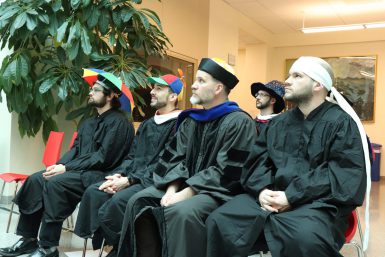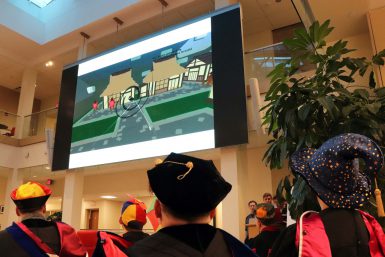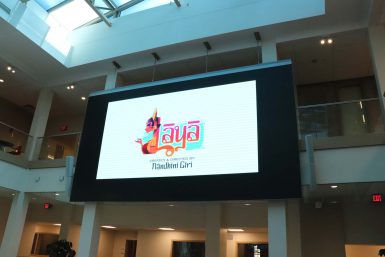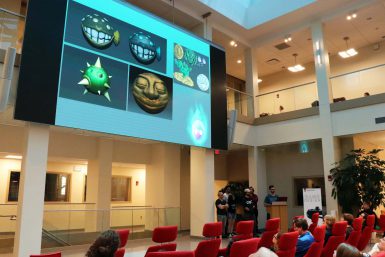Game design students present end-of-year showcase

On Thursday, May 3, IU game design students and faculty, along with their friends and family, gathered in the Franklin Hall Commons to look at what they have accomplished in the school year and what lies ahead for this still nascent program. This includes new games being made, new tech being explored and new outlets being offered for students.
“We take this work very seriously,” said Professor of Practice Mike Sellers, the Director of the Game Design program. “There’s a lot of deep thinking and deep theory, but also a lot of really fun stuff that goes into it. We’ve also worked really hard to build a really strong culture here in the program.”
As for what has been done this year, the graduating seniors have developed and published two games, “Tori” and “Witch of the Woods.” These teams were also assisted by a quality assurance group.

“Tori” is a PC game in which the player flies in the air as a little red bird through four mysterious floating islands, interacting with sounds in order to bring light to the world around it, Otokai. The whole experience lasts about thirty minutes and is deeply rooted in Japanese culture and tradition. The game also features an original haiku that progresses as the islands are explored, which has been translated into four languages, including Japanese.
The team of seven developers created their own company, Team Tori LLC, and published “Tori” for sale on various game platforms, including itch.io and Steam.
“Witch of the Woods” is another PC game in which you play as a witch who casts spells in order to manipulate the forest ecosystem and cleanse the woods of evil corruption. The player explores these woods and then collects materials to make specific spells that are intended to change the dynamics of the forest. The game started out as a board game and, over the two years it was being developed, the team worked to bring it into a digital format.
The team’s company is Druidic LLC and their game can be found on itch.io and is scheduled to be made available on Steam soon.

Besides games, the technology made available to the program was also used to make a short motion-capture film for the second year in a row. This year’s 10-minute film was called “Laya,” a Hindi word roughly translated to mean rhythm and movement. Like last year’s project, the team was comprised of several students and faculty members from different schools and departments.
“This is only the beginning,” said Nandhini Giri, an IU PhD candidate and former production coordinator at Dreamworks who served as the project’s creative director. “Every year we are planning on doing more projects like this, so any ideas you have going forward you can contact me and we can take it from there.”
Another IU graduate student, Kees Lyendijk, was also featured at the ceremony for his recently-made game, which also happened to be his thesis project. “Soul” is a narrative driven game that works through the feelings and memories of a woman whose daughter recently passed away. It’s goal, said Lyendijk, is to explore the tension between the difficulties of trying to move past such a traumatic event while also trying to hold onto values and work through memories.
By navigating through the narrative and collecting fragments in order to unlock memories and process the grief, Lyendijk said he wanted to give the players agency and allow them interact with the story in a meaningful way. In doing this, the player is taken through chapters of loss, grief and change.
All of these mechanics, according to Lyendijk, are meant to be a metaphor.
“The actions that we take inside a game allow us to understand or experience the game in a different way than just passively receiving it would,” Lyendijk explained. “This is a very unique affordance that we have for games as a medium and, unlike watching a movie, we are playing an active role in what it means to experience, what it means to feel the narrative that is unfolding.”

Looking forward, game design students in the earlier stages of the program are in the midst of designing three new games: “Dungeonomics,” “Imaginarium” and “Rollosus.”
“Dungeonomics,” is a dungeon business tycoon game where you hire monsters to kill heroes for profit. Player start out by constructing a dungeon that they can build on. Then, they hire the best monsters they can afford, kill heroes with them to make more money and then use the loot to better their technique and raise their infamy score.
“Imaginarium” is a virtual reality game that involves exploring various worlds found in a storybook in your character’s bedroom in an effort to collect all toys and fight enemies of the different worlds. The player opens the storybook, the level is then projected onto the rug in the room and then the player is transposed into that world where they fight aliens, pirates or goblins, depending on the level.

“Rollosus” is a game where players get to traverse a destabilizing world as a rolling ball and take on enemies and bosses in fast-paced combat. The game uses a hub and spoke level design in which the main area of focus, the hub, is where the players want to go, the spokes take the player off on different paths to accomplish various challenges.
While all of these teams have made some progress, they are still in the early stages of production. They need to tend to the mechanics and look of their games and they also need to start their companies, promote their brand and get their games published.
The ceremony was also used to announce that, because the game design program has grown so much in such a short period of time, IU’s long-time game design club, Hoosier Games, will be discontinued and replaced with a new club: Game Dev @ IU. According to Sellers, this club will be much more focused on providing opportunities for individual skill growth. Like Hoosier Games, the club will be split into smaller student teams. However, the teams will be focused on specific interests like animation, IU design and sound design. The games produced by the club will also be made in much shorter periods of time, made at game jams and featured and presented throughout the year.
Hoosier Games’ former president and graduating senior Jon Brown concluded the ceremony by saying that these changes are a sign that the program is growing and he encouraged all of the students to take advantage of everything that the school and club have to offer.
“It’s up to all of you students who are still here to take advantage of every opportunity you get to grow,” Brown said. “Seek every opportunity you can while you are here in the safe bubble of school to grow.”

